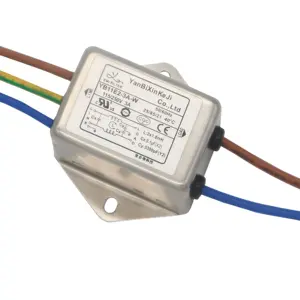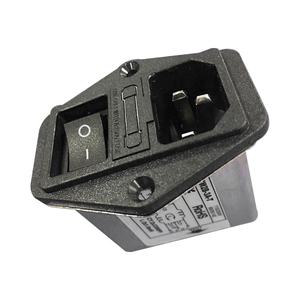What are Attenuators
Attenuators are fundamental components in the realm of electronics, particularly within telecommunications systems. They are devices designed to reduce the power of a signal without significantly degrading the integrity of that signal's waveform. This reduction in signal power is a crucial aspect for various applications, such as controlling the amplitude of a signal to match the input levels of other devices or reducing signal strength to safe levels to avoid damage to sensitive equipment.
The primary users of attenuators are professionals within the telecommunications industry, including network engineers and electronic technicians, who incorporate these devices in radio, television, and internet communication systems. Additionally, they serve an essential role in test and measurement setups, ensuring that equipment is operated at optimal signal levels.
Attenuators function based on principles of impedance matching and signal attenuation. They are often passive devices made from resistive materials that absorb part of the signal energy and convert it into heat. By carefully selecting the resistance values within an attenuator, it is possible to determine the exact amount of signal reduction. Some attenuators are also adjustable, allowing users to vary the level of attenuation to meet specific requirements.
The design and construction of an attenuator hinge on its intended application; for instance, some may be built for high-frequency applications while others cater to high-power signals. Regardless of design, all attenuators share the same core purpose: to precisely reduce signal levels while maintaining the integrity of the signal as much as possible.
Types of Attenuators
Attenuators come in various types to suit different technical requirements and applications:
Fixed Attenuators: These devices provide a set level of attenuation and are widely used in networking for controlling signal levels between different points in a system. They are simple, reliable, and often used when a constant reduction is needed.
Variable Attenuators: Offering adjustable levels of attenuation, these are crucial in research and development or testing environments where varying the signal strength is necessary for different tests or measurements.
Step Attenuators: These attenuators allow users to change the attenuation level in known increments or 'steps'. They are useful in calibration processes or where precise control over signal levels is required.
Programmable Attenuators: Designed for automated systems, these can be controlled through digital interfaces such as GPIB or Ethernet. They fit into setups requiring dynamic control over attenuation via software or remote commands.
High-Power Attenuators: As their name suggests, these are built to handle higher power signals without being damaged. They are essential in broadcast transmission systems or high-power testing scenarios.
Each type serves distinct functions depending on the requirement at hand; whether it's for a fixed setup or one that requires flexibility and control over signal levels.
How to choose Attenuators
Choosing the right attenuator is pivotal for ensuring system performance and reliability. When selecting attenuators for business purposes, consider the following:
Attenuation Level: Determine the range of attenuation necessary for your application. Whether you need a fixed value or an adjustable range will dictate whether you choose fixed, variable, or step attenuators.
Frequency Range: The operating frequency range is critical as attenuators are designed to work effectively over specific frequency bands. Ensure that the device matches your system's frequency requirements.
Power Handling: Consider the power level of your signals. For high-power applications, it's important to select attenuators that can handle the power without being damaged.
Connectivity: Attenuators come with various connector types like SMA, BNC, or N Type. The connectors should be compatible with other components in your system for seamless integration.
Quality and Reliability: For business applications where uptime is crucial, choosing attenuators from reputable suppliers with proven track records ensures consistent performance and durability.
Incorporating these considerations will assist businesses in selecting attenuators that not only meet their current needs but also offer room for scalability and flexibility for future system upgrades or expansions.
Best Attenuators on Alibaba.com
Alibaba.com stands as a premier online marketplace connecting businesses across continents with a vast selection of electronic components, including a comprehensive range of attenuators suitable for various telecommunication needs. The platform's extensive collection offers an array of choices catering to any technical specification required by professionals in the industry—from fixed and variable attenuators tailored for precise signal management to high-power options designed for robust performance under demanding conditions.
Buyers on Alibaba.com benefit from an efficient and user-friendly shopping experience that empowers them to find products that align with their specific requirements. The diversity of products available ensures that whether you manage a small-scale operation or oversee large network installations, you'll find suitable attenuators that adhere to your project's technical demands without compromising on quality.
Moreover, Alibaba.com's commitment to facilitating smooth international trade makes it an ideal source for global businesses seeking reliable electronic components. With services like Trade Assurance providing payment protection until delivery completion and suppliers vetted for trustworthiness, customers can engage in transactions with confidence. Alibaba.com strives not only to supply a breadth of product options but also to ensure secure and satisfactory trading experiences for businesses around the world.
Common FAQs for Attenuators
What is an attenuator and why is it used in telecommunications?
An attenuator is a device that reduces the power of a signal without significantly altering its waveform. It's used in telecommunications to adjust signal levels to prevent overloading or to match levels between different stages of a system.
How do fixed attenuators differ from variable attenuators?
Fixed attenuators reduce the signal by a specific amount, which cannot be changed, making them suitable for applications where a constant level of attenuation is required. Variable attenuators, on the other hand, allow for adjustable attenuation levels, providing more flexibility in controlling signal strength.
Can attenuators be used for both analog and digital signals?
Yes, attenuators are designed to work with both analog and digital signals. However, it's important to ensure that the attenuator's specifications, such as frequency range and power handling, are compatible with the specific signal type.
What should I consider when selecting an attenuator for high-frequency applications?
For high-frequency applications, considerations should include the frequency range over which the attenuator operates effectively, its return loss or VSWR (Voltage Standing Wave Ratio) characteristics for impedance matching, and its power handling capability to ensure it can manage the signal levels without damage.
How does power handling capability affect my choice of an attenuator?
An attenuator's power handling capability indicates the maximum amount of power it can safely dissipate without being damaged. For high-power applications, it is crucial to select an attenuator that can handle the power levels of your system to avoid equipment failure.
What types of connectors are commonly used with attenuators?
Common connector types for attenuators include SMA, BNC, N Type, and others. The choice depends on compatibility with existing equipment and the frequency range and power level of the application.
Are there any industry standards for attenuators that I should be aware of?
Yes, industry standards such as those from IEEE (Institute of Electrical and Electronics Engineers) or IEC (International Electrotechnical Commission) may apply to attenuators. These standards ensure compatibility and reliability across different systems and components.
How do I know if an attenuator is compatible with my existing telecom system?
To ensure compatibility with your telecom system, check the specifications of the attenuator including frequency range, power handling, connector type, and impedance. These should match or exceed the requirements of your system.
Is it necessary to calibrate an attenuator?
Calibration might be necessary for precision applications where exact signal levels are critical. This is particularly true for variable and step attenuators used in test and measurement environments where accuracy is paramount.
How do I maintain an attenuator?
To maintain an attenuator, keep it clean from dust and debris which can affect its performance. Also ensure that it is not subjected to power levels beyond its specification to avoid damage.
Can I use multiple attenuators in a single application if I need higher attenuation?
Yes, you can cascade multiple attenuators to achieve higher levels of attenuation. However, each additional component may introduce more signal loss than just attenuation and could potentially affect overall system performance.
What is meant by 'attenuation range' in a variable or step attenuator?
The 'attenuation range' refers to the minimum and maximum levels of attenuation that a variable or step attenuator can provide. This range determines how much you can decrease a signal's power using the device.
How does temperature affect an attenuator's performance?
Temperature can affect an attenuator's resistance and therefore its ability to dissipate power. It is important to use an attenuator within its specified temperature range to ensure stable performance.
Are there any safety considerations when using high-power attenuators?
When using high-power attenuators, it's important to handle them with caution as they may become hot due to power dissipation. Ensure proper ventilation and adherence to safety guidelines to prevent burns or other injuries.












































 浙公网安备 33010002000092号
浙公网安备 33010002000092号 浙B2-20120091-4
浙B2-20120091-4